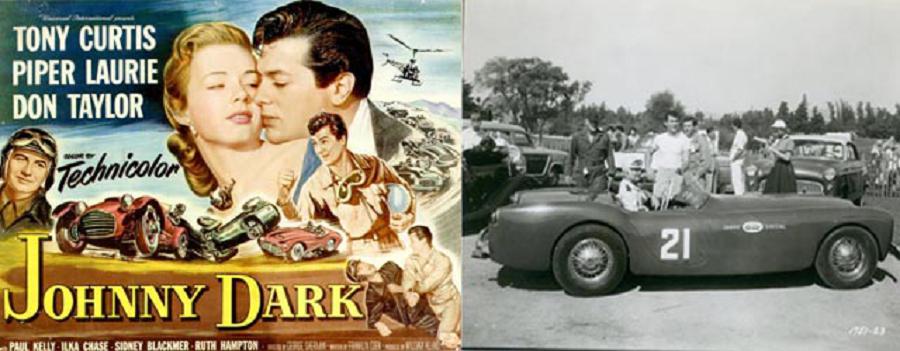
Hi Gang…
If you love the vintage fiberglass cars of the early ‘50s – the 1954 movie “Johnny Dark” is for you. It has everything a car guy would want in “car guy” movie:
- Sports car races – one actual race filmed at the Goleta, Santa Barbara Airport during Labor Day of 1953 and a second “cross country race” – based on the Carrera Panamericana Road Race in Mexico that had started in 1950.
- Boy (Tony Curtis) meets girl (Piper Laurie) – but this time it’s a “car-based” romance
- Fantastic filming of the race – filmed up and down the mountains with at least one car (Chuck Tatum’s sports car – 6 cylinder GMC) providing the real sounds for the movie, and race scenes filmed by helicopter – nearly a first for sports car / race car movies
- Competition – between the main character Johnny Dark and his good friend “Duke Benson” played by Don Taylor
- And of course – our favorite fiber-cars vying for the lead including a Glasspar G2, Victress S1, Woodill Wildfire, Grantham Stardust, Irwin Lancer, Chuck Tatum’s “Tatum Special,” Bohman Special, and a Kurtis Sports Car. The Glasspar spins out….the Grantham Stardust spins out….the Bohman Special spins out…..so much action!
And these cars were chosen for a reason – as you’ll learn later in today’s story – straight from the folks who created the movie.
A Fiber-Match Made in Sports Car Heaven:
We couldn’t have asked for a more perfect movie showcasing the best of what 1953 had to offer in American fiber-powered sports cars. But given all of these facts, the movie was actually far more historically important than any of us might think. It came out at a time when building your own sports car was something that was top of mind to young American men, and sports car magazines knew it. So did movie studios.
Fiberglass sports cars were featured time and time again on the covers of American sports car magazines in the early and mid ‘50s. In fact, there were over 100 magazine cover appearances of these cars in the 50’s alone – and we’re still finding more magazine covers these cars appeared on – as recently as last month. Click here to see many of the cover car appearances of these fiberglass sports cars from the ‘50s and beyond.
But who else knew how important this movie was to the American sports car public? What organization was astute enough to put all the pieces of the puzzle together? This would be…
- An organization keenly aware of the sports car movement….
- An organization that understood that if they were going to put together a sports car film that would sweep the nation, it would have to light a fire underneath the young American guys anxious to build, run, and race their own sports car….
- An organization that had the financial capacity to bring innovative builders and designers to the table and showcase their limited production sports cars with the American public…
Who was this mysterious organization?
Why you’ve heard of them before and you’ve heard of them today – none other than Universal-International Pictures – now called “Universal Studios.”
Production Notes: Creating The Theme and Vision Of A Movie In Progress
As you read thru this seven page “Production Notes” document from Universal-International Studio, you’ll see some very important issues they stressed. These points were intended to guide the production of the movie, excite those interested in the theatrical distribution, and to spread the message on what, when, where, and why the movie was being made – it was intended to be read by a world-wide audience, and ramp up their interest.
Here are some of the issues you’ll read about in these “Production Notes:”
- The importance of the sports car movement sweeping America
- The use of realistic and accurate locations for all filming including the Willys Motor Plant in Toledo, Ohio; the Packard Proving Grounds in Detroit Michigan, and the road race at the Santa Barbara airport in Goleta, California.
- The use of top car designers turning out special cars for the film. As stated in the “Production Notes”, “These vehicles, in many respects, are years ahead of their time and are expected to be of great influence in the design of commercial cars.”
- Designers identified included Howard “Dutch” Darrin (his car – Kaiser Darrin – did not participate…we’ll discuss why in future stories that involve the prototypes of the Kaiser Darrin sports car in 1953), Frank Kurtis and his Kurtis Sports Car, Norbert Kraker – builder of several Grantham Stardust sports cars, Chuck Tatum, Bowman and Sons of Pasadena California, and B.R. “Woody” Woodill’s Wildfire – the lead car(s) in the movie.
- The filming of an actual road race for the first race in the movie and the entry of the lead car for the movie in that same race – a real road race at Santa Barbara during Labor Day in 1953. During the race, the car entered – the Woodill Wildfire – was driven by stunt man and technical advisor for the film – Haile Chace – and the scenes were used in the first race shown in Johnny Dark. Haile was also a race car driver in the early ‘50s.
- The use of various scenes across 2000 miles of Western America to film the main race of the movie.
- Statistics were discussed including the growing sports car phenomenon in America and how it was impacting the production of cars – sports cars – in Detroit, Michigan.
- Explanation of what a sports car is – and is not.
- The growing “cult” of sports car aficionados, and their allegiance to various makes
- The explosion of car enthusiast magazines in the postwar era
- The creation of various sports car clubs across America
- The expansion of sports car road races in various locations across the country
- The “mentoring by” and “use of” Louis Tomei – famous Indianapolis 500 race car driver – to train Tony Curtis on how to accurately handle a sports car. Tomei also drove one of the cars in Johnny Dark.
- Although not mentioned in the production notes, Don Freeland – another Indianapolis 500 driver – drove the Victress in the movie; Phil Hill and Chuck Tatum – both famed race car drivers on the West Coast and beyond – stewarded cars; Carey Loftin, Johnny Daheim, and H. Haile Chace also drove – these were stuntman and race car drivers on the west coast. And Eric Irwin – designer and builder of his Irwin Lancer drove his car in the movie too.
- And finally, the list of “talent” used at all levels of the movie was the very best. The production notes spend nearly two pages discussing the background, fame, and importance of the actors chosen and why.
So there’s a lot to take in, but if you love history and insight in first person accounts from “back in the day” – these “Production Notes” from Universal in early 1954 will delight you to no end.
Let’s have a look at what these notes had to say – so get some coffee and away we go
Johnny Dark: Production Notes
Universal International Studios
February 23, 1954
The sports car craze now sweeping the country provides the thematic background for Universal-International’s Technicolor production of “Johnny Dark,” produced by William Alland with George Sherman directing a cast headed by Tony Curtis, Piper Laurie, Don Taylor, Paul Kelly, Ilka Chase, Sidney Blackmer and Ruth Hampton.
One of the most vigorous movements in the nation’s automotive field, the widespread interest in sports-type vehicles is fast beginning to revolutionize Detroit’s busy assembly lines, with U-I being the first studio to base a feature film on the timely subject.
In the early days of motion pictures the racing car story figured prominently in action fare, with the contributions of Reginald Denny, William Haines and the late Wally Reid being best remembered. Not until plans were actively under way for “Johnny Dark” was it discovered that the very first motion picture dealing specifically with sports cars was one produced by the old Universal studios. This was “Sporting Youth,” made in 1924, with Denny as the dare-devil hero.
To give documentary authenticity to the screenplay, director Sherman moved cast and crew to Toledo, Ohio, to make use of facilities of the vast Willys Motors plant. The $62,000,000 factory, covering more than 5,500,000 square feet of floor space in 70 buildings, provided one of the most grandiose sets ever employed by Hollywood film makers.
A first-hand view of all the steps involved in construction of an automobile, from first blueprints to final assembly, was recorded by the cameras. For purposes of the screenplay (authored by Franklin Coen) the Willys cars shown in the footage were slightly modified, with the name of the vehicle changed to Fielding. Following Toledo sequences the troupe moved to Detroit where the newly completed two-and-one-half mile proving grounds of Packard Motor Car Company were pressed into use. An engineering marvel, the oval testing track is so carefully designed that a driver is able to negotiate the turns at high speed almost without keeping his hands on the steering wheel.
Because most of Detroit’s contemplated domestic sports vehicles are as yet in blueprint state, the studio made arrangements with a dozen top car designers to turn out special models for the film. These vehicles, in many respects, are years ahead of their time, and are expected to be of great influence in the design of commercial cars.
Designers represented in “Johnny Dark” include Howard A. Darrin, who created the Kaiser-Darrin KF-161; Frank Kurtis, of Kurtis-Kraft; N.J. Kraker, famous for his Grantham “Stardust” special; Chuck Tatum, of Stockton, Calif., builder of the Tatum Special; Bowman and Sons, of Pasadena, Calif., and B. R. “Woody” Woodill, one of the nation’s foremost men in the field.
Among sports car enthusiasts several types of races are officially recognized — the road race, and what is known as the airport race, over a fixed course. Both types are shown in “Johnny Dark”. For the latter the studio filmed a Labor Day run at the Santa Barbara (Calif.) Municipal Airport. The studio entered its own vehicle in the contest with Haile Chace, noted race driver, who also served as technical adviser for the picture, at the wheel. Foreign sports cars seen in this footage include such well-known makes as the Jaguar, Allard, Bentley, Alfa-Romeo, Fiat, Ferrari, Maserati, Lancia, Bugatti, Simca, Delahaye and Mercedes-Benz.
In staging the filmic road race, depicted as a border-to-border run from Canada to Mexico, additional location work took the peripatetic troupe over more than 2000 miles of territory between the boundaries of the neighboring nations. To facilitate photographic coverage, cinematographer Carl Guthrie used a helicopter especially adapted for the addition of camera gear.
Technical advisor Chace disclosed that sports cars enjoyed considerable vogue in the United States prior to the first World War, but that thereafter most of the interest shifted to Europe, and not until after World War II, when American servicemen returned from overseas, carrying with them favorable impressions of the foreign runabouts, did the fad begin to regain ground.
Statistics amassed by the Automobile Manufacturers Association reflect the over-all story. From 1940 to 1945, only 464 new and 1962 used foreign cars were imported into the United States. But from 1946 through 1952, 113,409 new and 2693 used foreign vehicles were brought in. For 1952 alone, the imports totaled more than 30,000.
First of the domestic sports cars off Detroit’s assembly lines was the Nash-Healey, which appeared in 1950. It was seen in international competition the same year in the rigorous 24-hour road race at LeMans, France, placing fourth against the best of the world’s sport cars, the first time an American-powered vehicle had done so since 1921. The following year, in the same race, the car took sixth place, and 1952, finished third.
Also in production, by Chevrolet, is another sports model, the Corvette. Cars intended for the sports market, but not meant for competition in racing, include the Buick Skylark, the Cadillac El Dorado, the Oldsmobile Fiesta and the Packard Caribbean.
Among aficionados a sports car is differentiated from the ordinary passenger car in that it is equipped with a high-performance engine, has correct weight distribution, a low center of gravity, high power-to-weight ratio, and possesses a steering mechanism which makes it unnecessary to turn the wheel too many times to make a sharp bend in the road.
Contrasted numerically with America’s annual passenger car production — 4,320,788 in 1952 — the total number of sports cars in the United States does not seem too impressive. But each sports vehicle, because of its distinctive lines, generally gets special attention, and the cult of enthusiasts is growing apace. Matching the development of popular interest has been the mushrooming of magazines slanted for this special field. There are currently more than a dozen such publications on the stands, with one of the leading magazines, Motor Trend, guaranteeing a circulation of 400,000 copies a month.
Numerous organizations have sprung into being for sports car owners. Biggest is the Sports Car Club of America, with headquarters in Westport, Conn. It boasts some 4000 members in 37 regions, covering the United States and Canada. Leading American road races now include the annual tests at Watkins Glen, N.Y.; Bridgehampton, Long Island; Sebring, Fla.: Elkart Lake, Wisc.; and Pebble Beach and Golden Gate Park in California.
For his starring role in the picture, Tony Curtis trained for many weeks with veteran race pilot Louis Tomei, famed for his many runs on the grueling Indianapolis Speedway. Curtis became so expert that Tomei finally awarded the actor a “diploma” by permitting him to handle the wheel on a 125-mile-an-hour run around a test race, with Tomei as co-driver.
Curtis became the envy of all his friends, and of other sports car enthusiasts, when the studio permitted him to use the sleek, streamlined movie car for private purposes, just to make sure that he became thoroughly familiar with its operation. He plays the title character in the picture, a brilliant young design engineer at an old-line automobile plant.
His leading lady, lovely Piper Laurie, is seen as Liz Fielding, daughter of the plant owner, who is a design consultant. This assignment marks the fourth teaming of the popular couple, their previous pictures having been the highly successful “The Prince Who Was a Thief,” “No Room for the Groom,” and “Son of Ali Baba.”
Director Sherman arranged a pleasant surprise for Miss Laurie when, during location shooting at Lake Tahoe, he surreptitiously arranged for the star’s mother, Mrs. Charlotte Jacobs, to appear with her in one scene in which she stands in line to wait for an autograph. Don Taylor, recently seen with Bill Holden in “Stalag 17,” appears as Tony’s war-time buddy, Duke Benson, a test driver, who vies with him for the affections of Miss Laurie. Taylor was borrowed from his home lot, Paramount, for the assignment.
The impressive supporting cast reads like a Broadway “Who’s Who.” Paul Kelly, seen as Jim Scott, chief engineer at the plant, was the first child star in motion pictures, going back to the old Vitagraph days when the Kelly family lived across the street from the studio in Flatbush, Brooklyn, where Kelly was born. He became known as “The Vitagraph Boy.” Later he appeared in the first two-reeler ever made, “Billie’s Burglar.” In recent years he has appeared in numerous hit plays in Gotham.
Ilka Chase, cast as Abbie Binns, a private secretary at the plant, is one of New York’s most talented citizens, being recognized as an actress-lecturer-novelist-wit. The assignment in “Johnny Dark” marks her initial screen role since “Miss Tatlock’s Millions.” On Broadway she made a memorable performance as harpish Sylvia Fowler in “The Women.” She is currently engaged, in her spare moments, in the completion of a biography of her mother, Edna Woolman Chase, for more than 40 years the editor of Vogue magazine.
Sidney Blackmer, portraying James Fielding, the plant owner, won both the coveted Donaldson Award, and the Antoinette Perry “Tony” for his work in “Come Back Little Sheba,” which ran for more than a year on Broadway. Although he and Kelly have been close personal friends for many years, they had never before appeared together in a film.
Ruth Hampton, the brunette beauty who was named “Miss New Jersey” in the 1952 Miss Universe Contest, reaches the screen in the role of Miss Border-to-Border, official queen of the big auto race.
One of the unscheduled performances in “Johnny Dark” was that of Senator Pat McCarran, of Nevada, who was in Reno at the time the company located there, and who was persuaded by director Sherman to appear as himself in the film, serving as official starter for the first leg of the race.
Summary:
To us today, the movie “Johnny Dark” looks like a nice, quaint, “B” sports car movie from the 1950s. Good friend Chuck Tatum who was in the movie – driving his own car shown behind the Irwin Lancer in the above picture – corrected me immediately when I shared this thought with him as follows:
“Geoff…remember that “Johnny Dark” was done at a time when sports cars were exploding across America. Universal used their top talent – Tony Curtis and Piper Laurie….”A level” stars – as their leads. And other actors used were quite famous on their own. In fact, when I first got involved with the movie in the Fall of ’53 there was talk about making this movie a “3D” picture (popular at the time) – but that never materialized.
My business partner, Andy Botto, was paid $5000 at the end of the race scenes in the Fall of ’53 for keeping the Willys motor running in the Woodill that was used. Money was lavishly spent in making the best film possible at the time – an “A level” movie all the way.”
So heed the words of Chuck Tatum. At first we may have thought of this as a quaint ole sports car movie with our favorite cool cars. But in reality – it was actually much more. Johnny Dark captures in one film the excitement, thrill, and adventure of driving – and racing – your own American sports car at a time we now call the “Golden Era of Postwar Racing in America.”
They couldn’t have produced a better film to capture the spirit and the moment.
Hope you enjoyed the story, and until next time…
Glass on gang…
Geoff
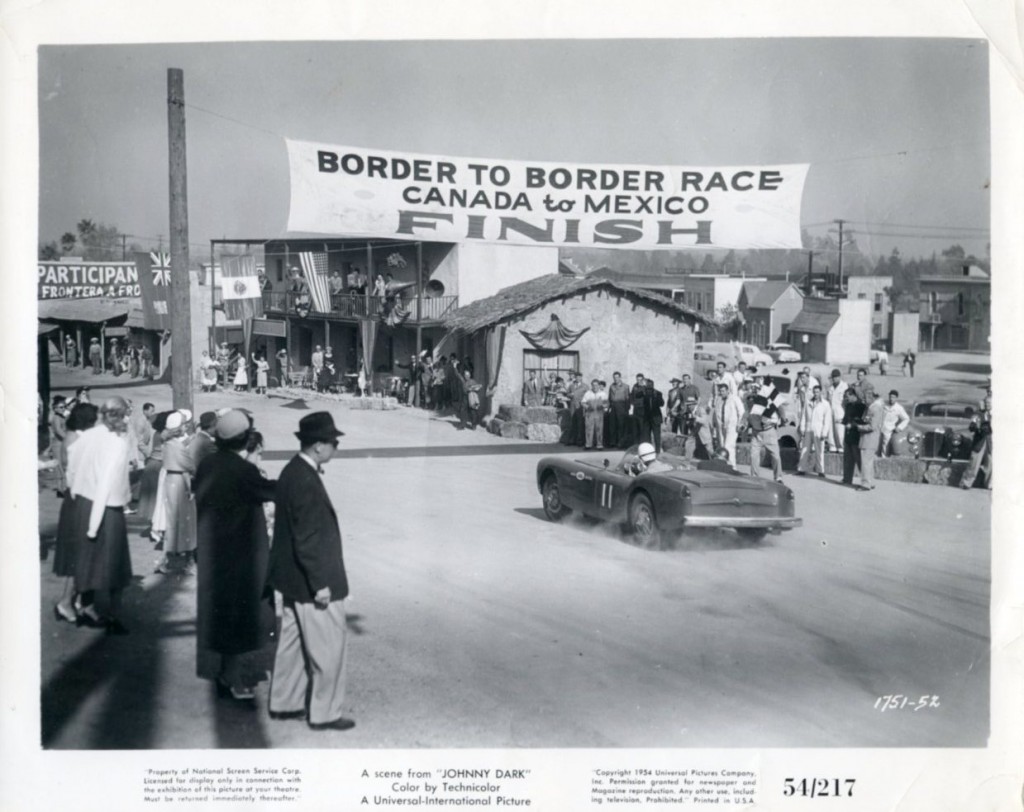
——————————————————————-
Click on the Images Below to View Larger Pictures
——————————————————————-
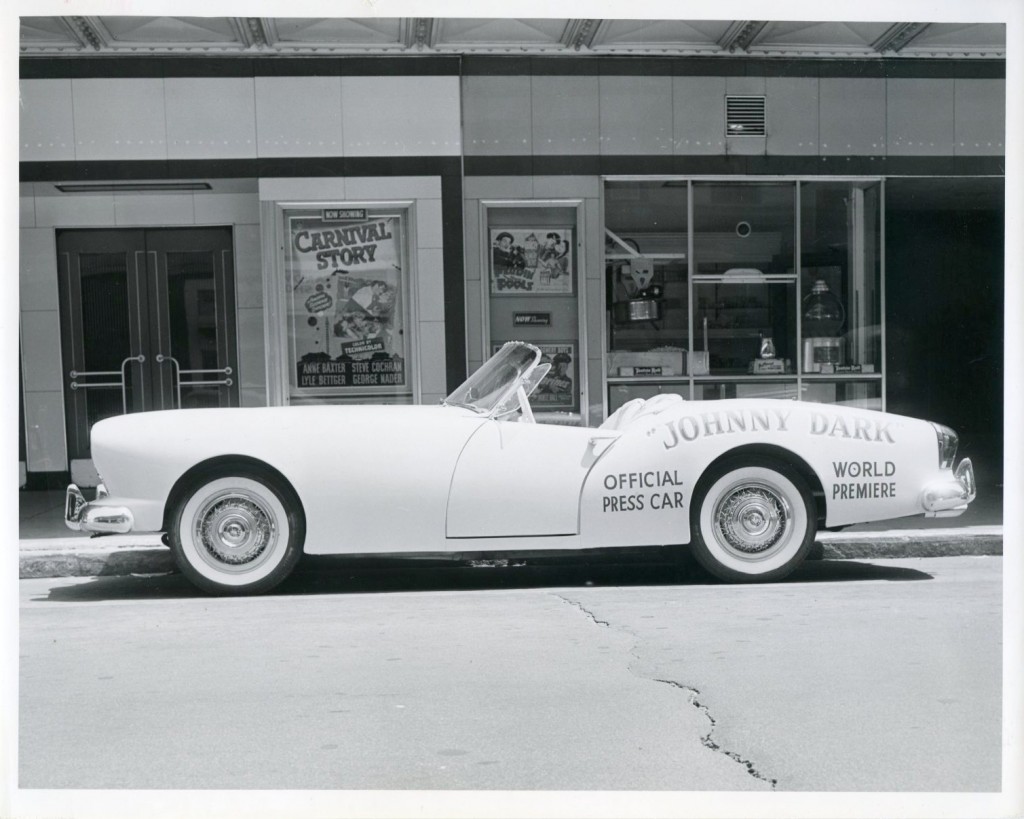
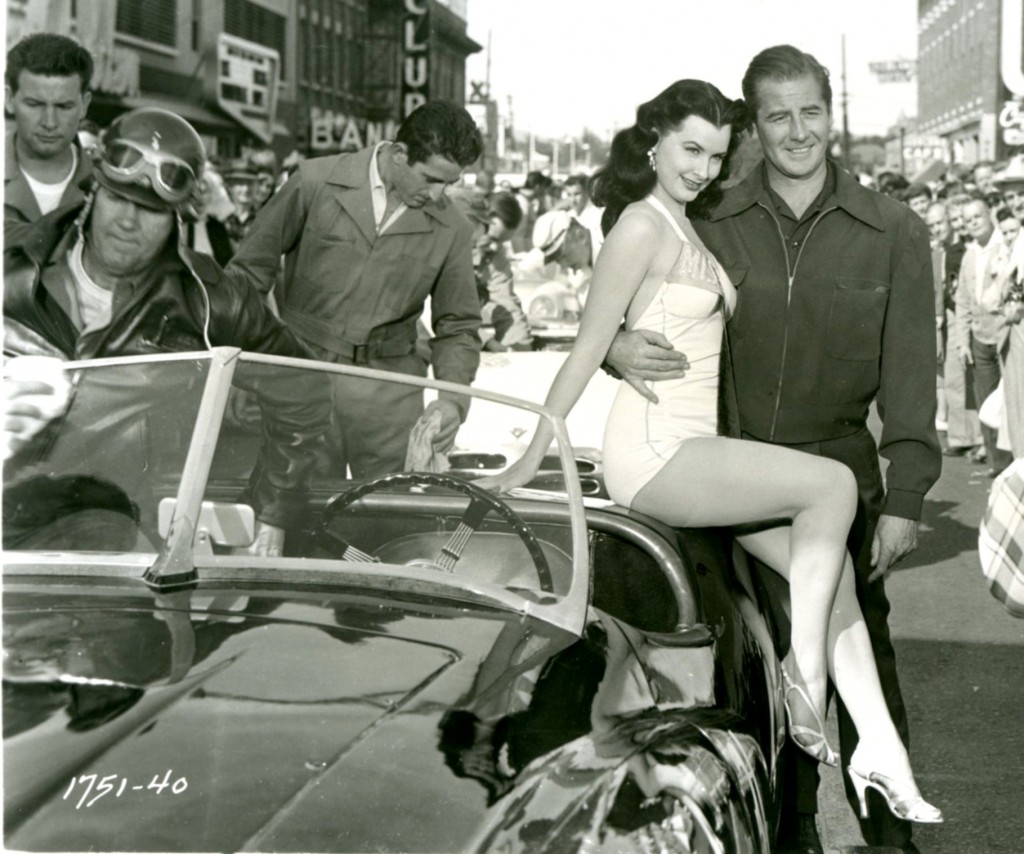
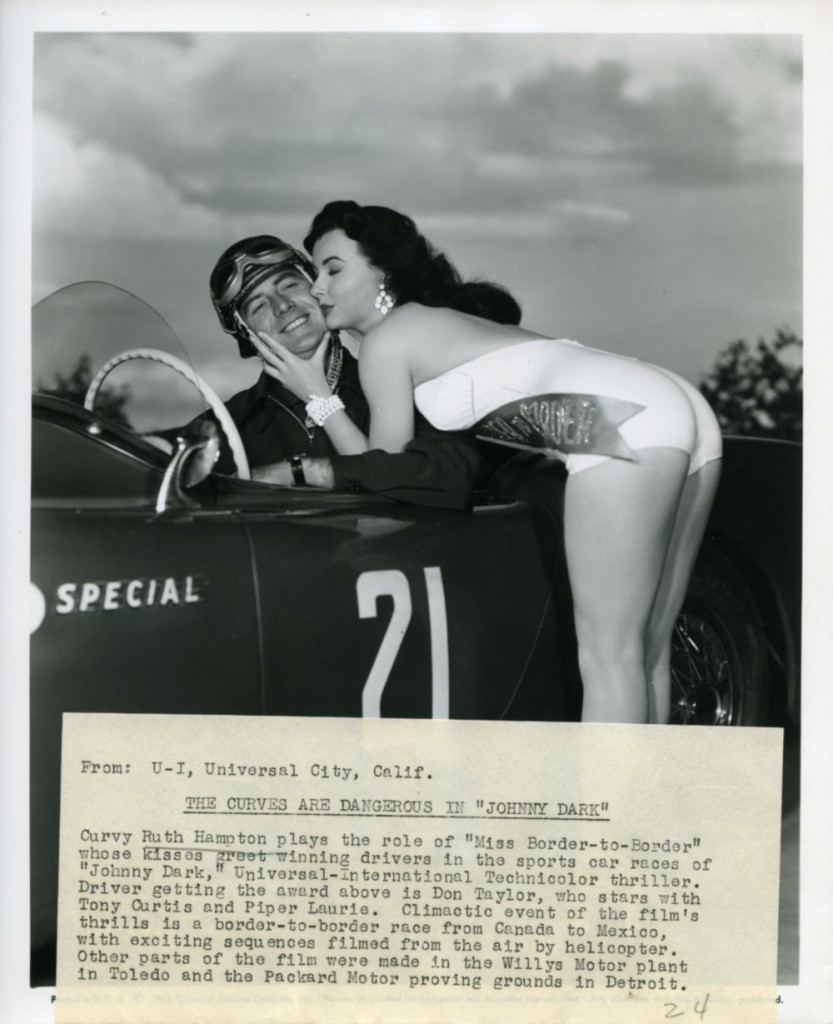

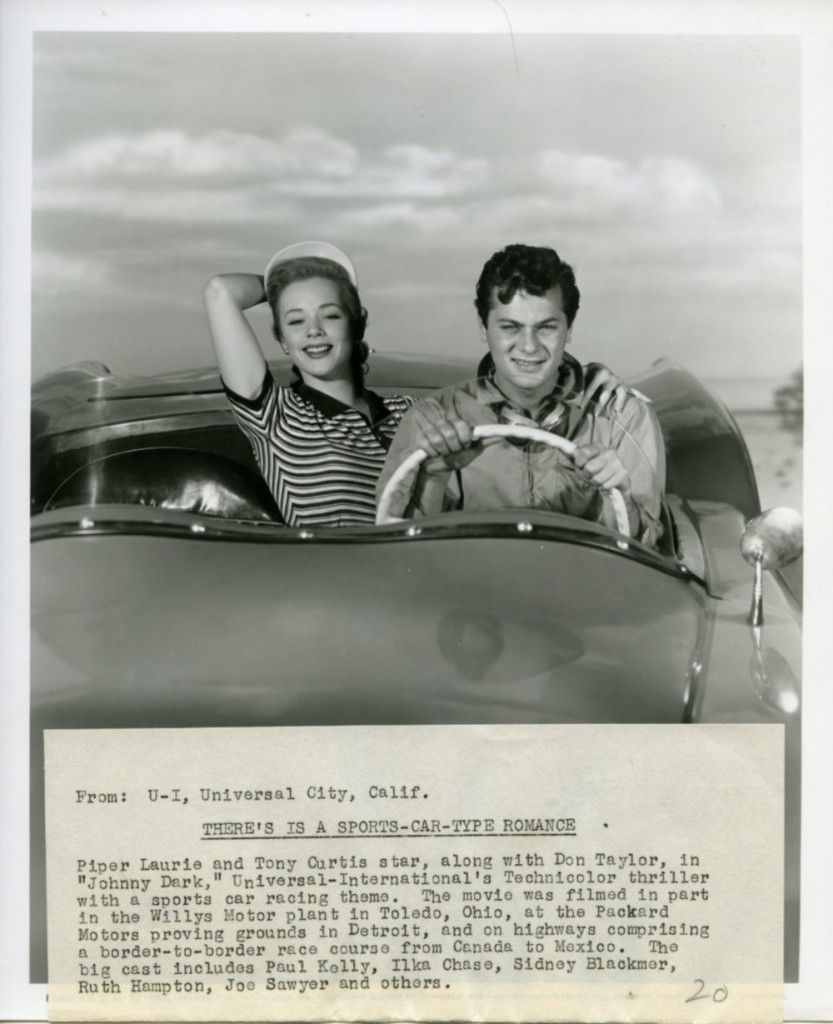

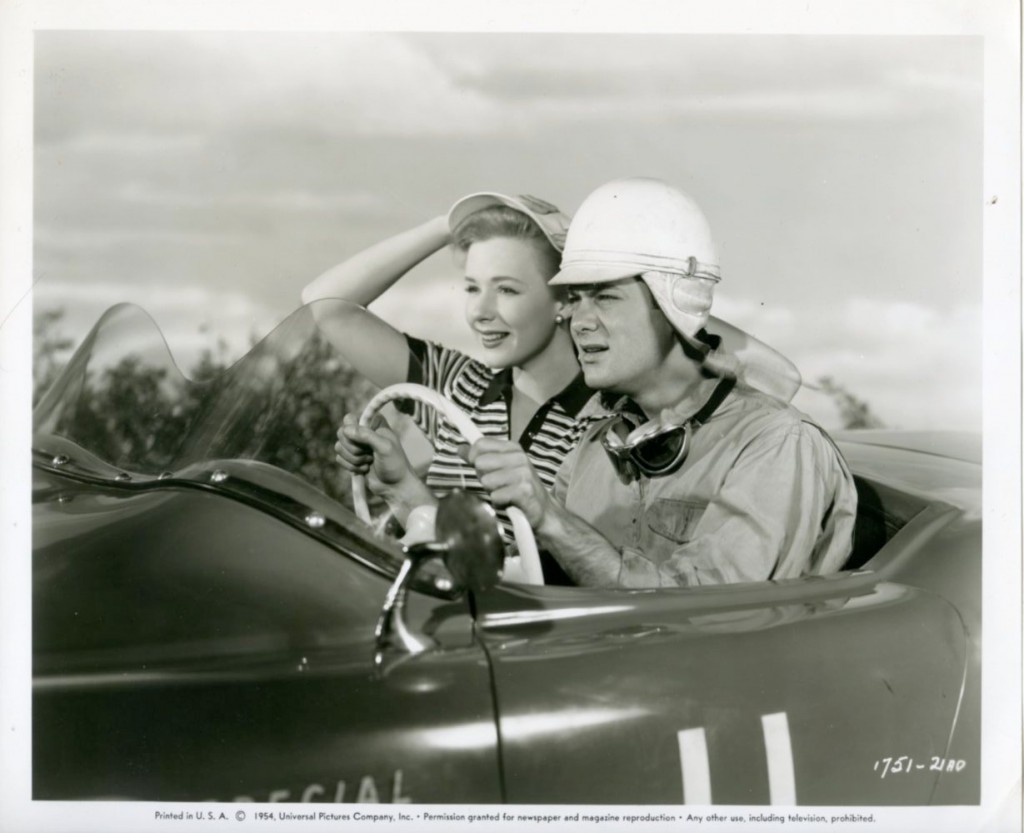
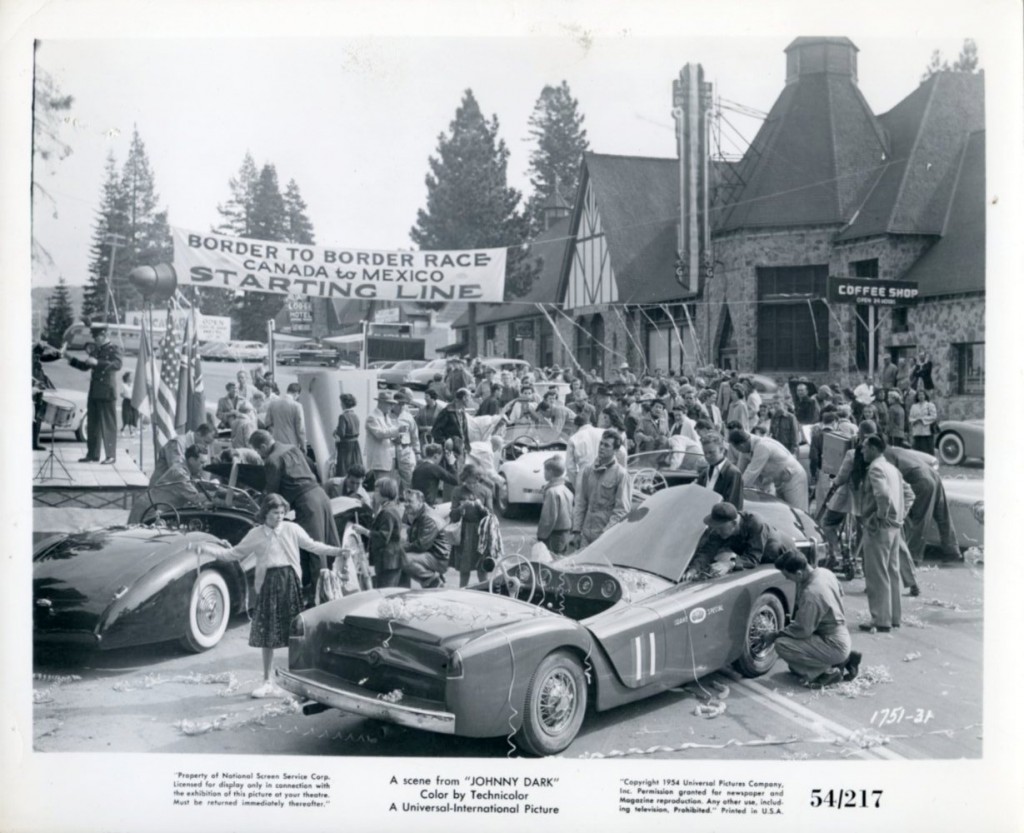
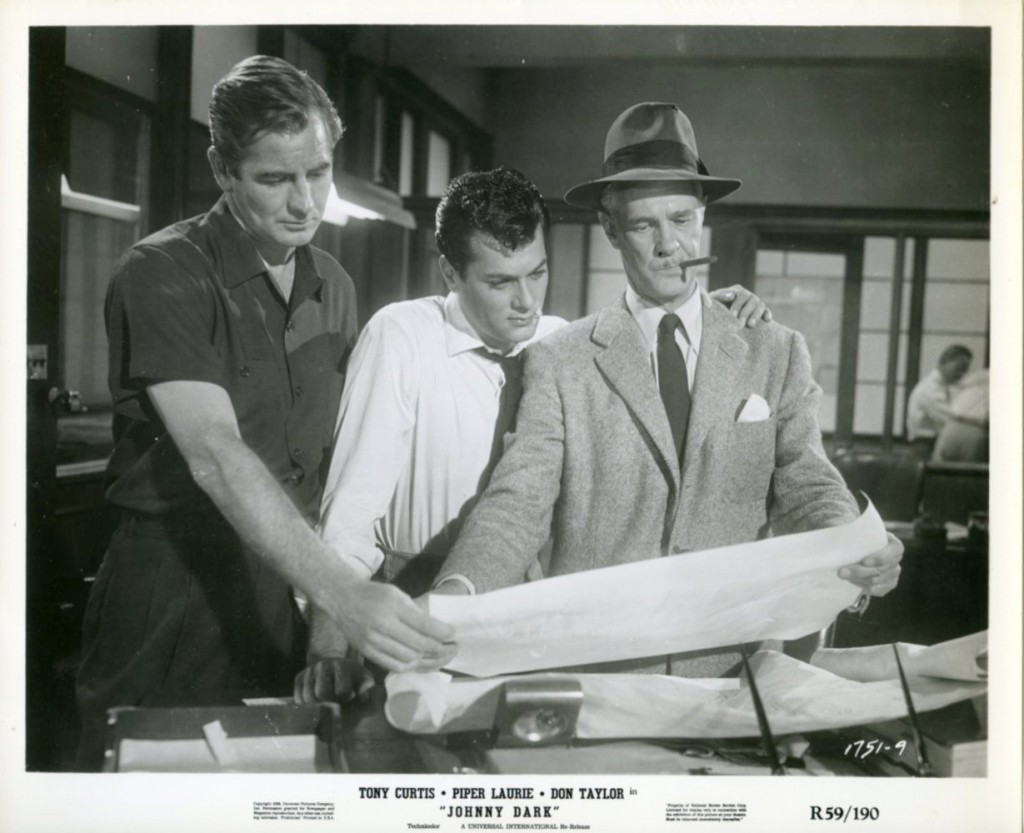

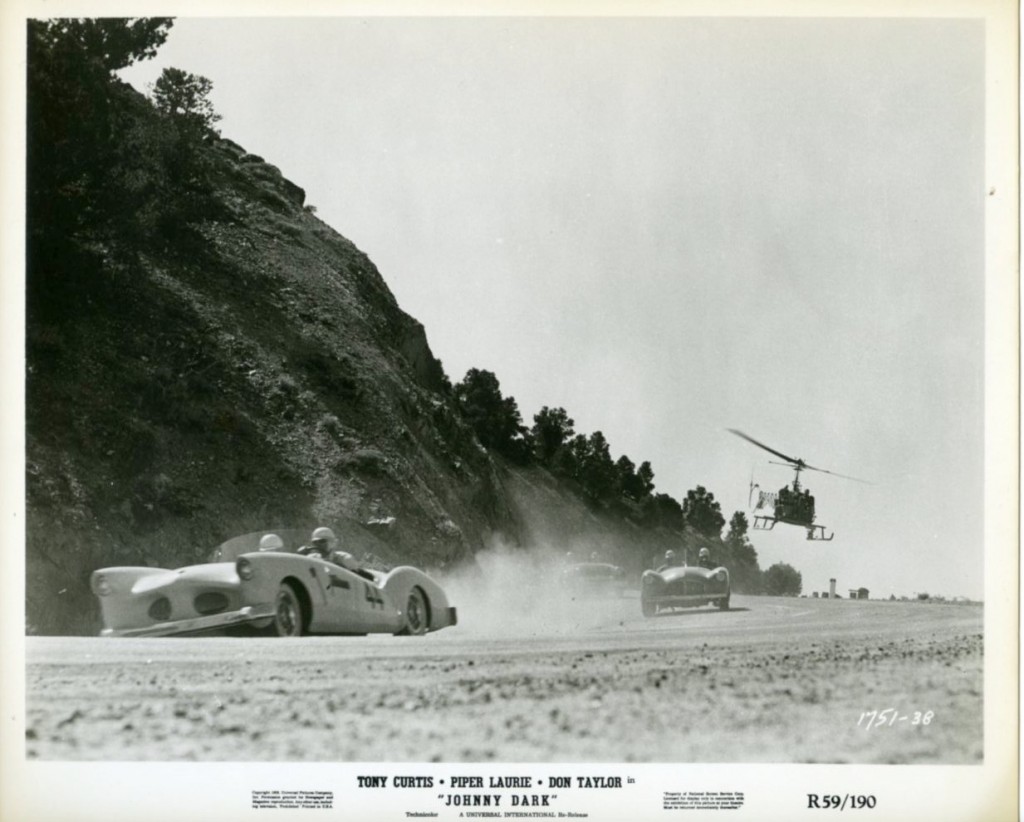
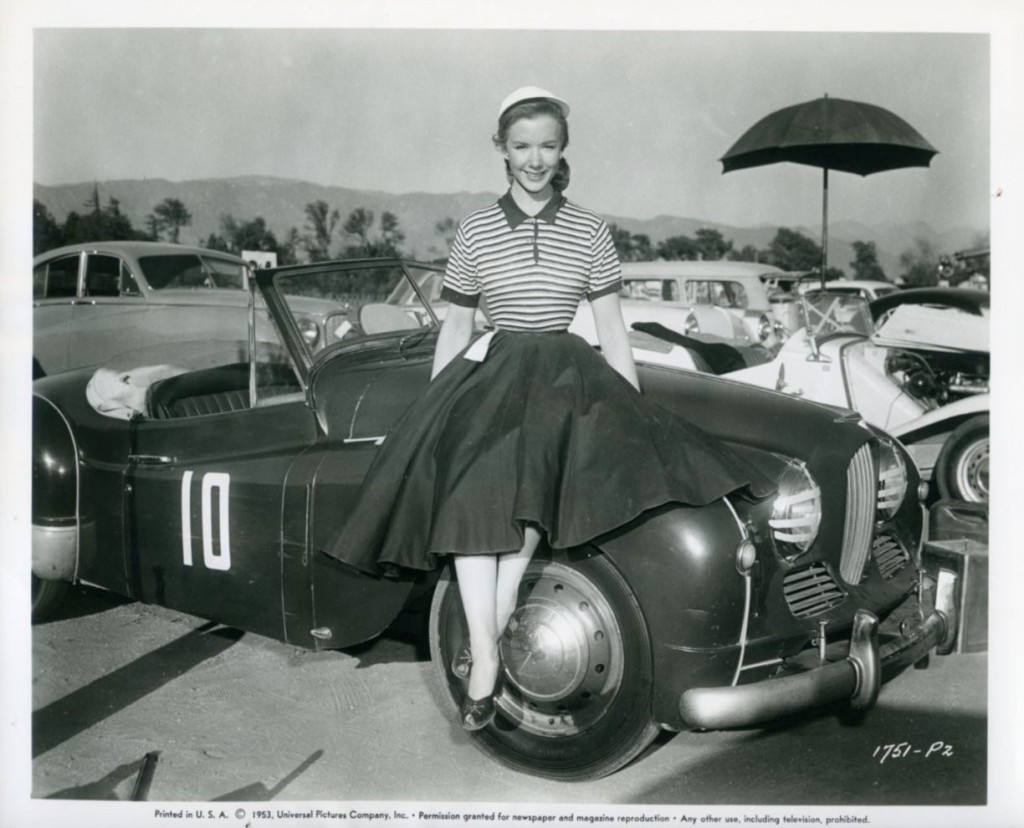
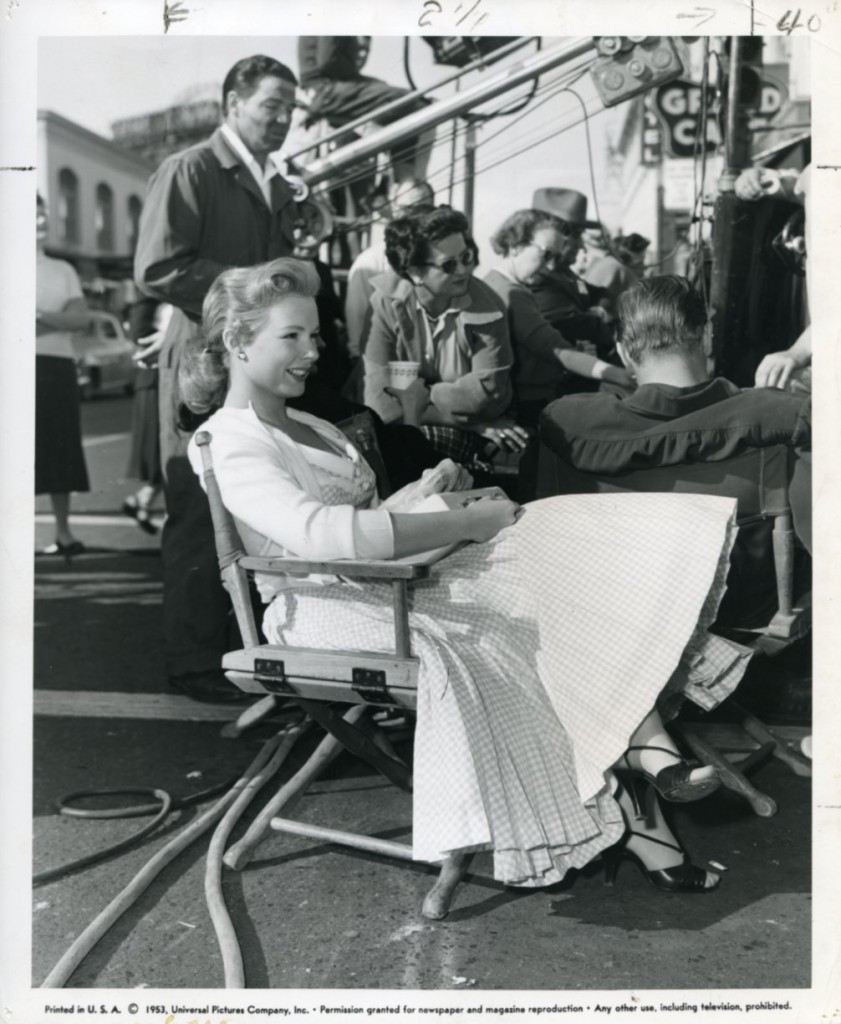
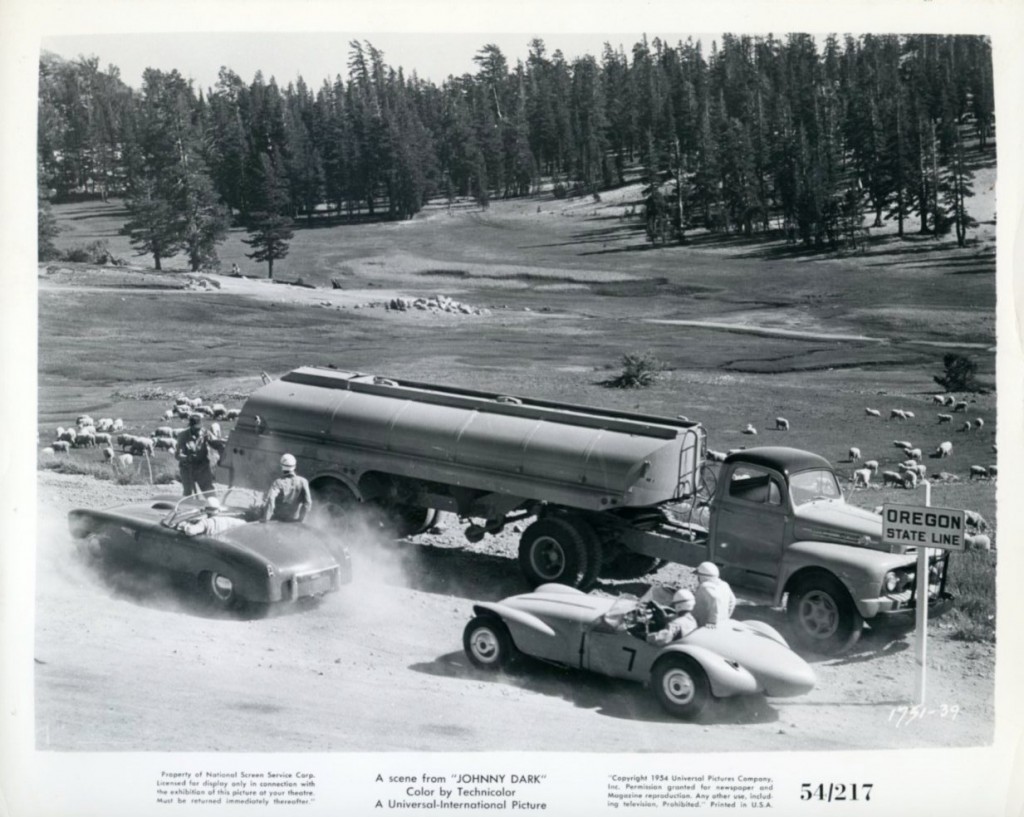

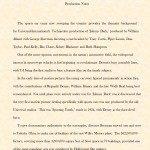
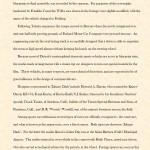
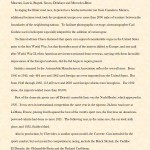
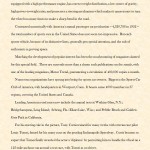
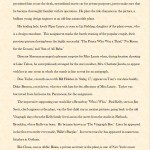
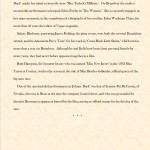
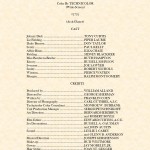
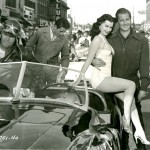
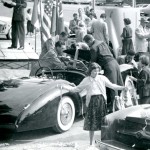
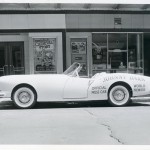
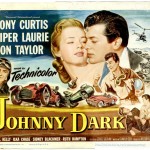
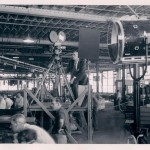
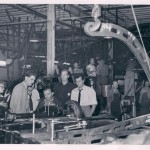
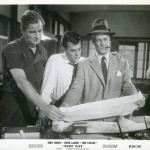

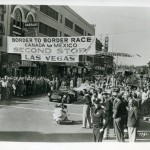
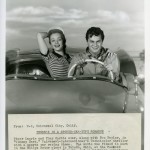
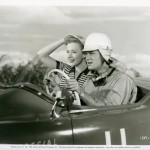
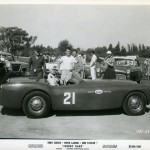
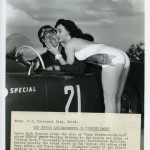
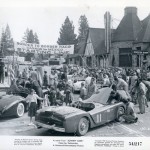
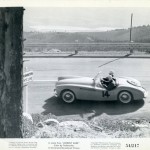
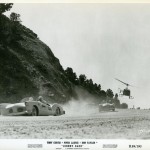
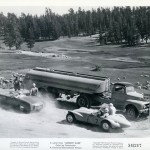
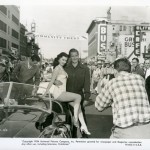
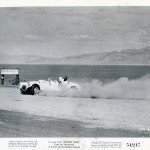
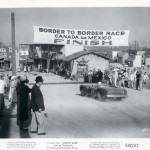
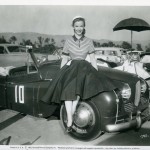
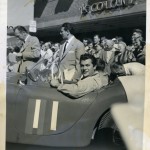
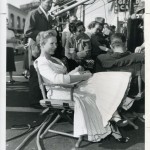
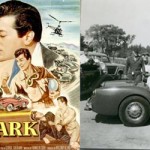
I saw this movie as part of a Tony Curtis marathon a long time ago.I laughed when I saw the Fiat though, I didn’t think they were race cars! Then again, some of the fiat 500 used for sale I’ve seen around my area have been suped up by previous owners, so maybe it does have something to it. Great post!
Thanks Frank. Johnny Dark was really built as a vehicle to promote the sports car hobby along with the release of the movie too. Wait ’till you see the other pieces that Universal produced for theater owners to engage the sports car enthusiast and have him/her view and promote the movie. The summer of ’54 must have been an exciting time for sports car enthusiasts who loved movies Geoff
Geoff
More information than I was ever able to accumulate on the movie. Kudos, Geoff. The production notes are fascinating. I’ve seen some of the stills before, can’t wait to see the remainder. The movie itself is a good fun watch; I recommend watching it if one has the opportunity.
————DITTO———–
Mel
A hugely important article in the “Must Read” category. As has been pointed out, this was a serious effort by the Hollywood establishment to produce a first rate movie as an exciting “blockbuster”, but also to capture an emerging cultural revolution involving America’s love affair with cars, especially of the sporting variety. One has only to look at the rapidly increasing import numbers of the time to see the beginnings of the influence of sports cars on the mainstream automotive scene.
The Forgotten Fiberglass story is as much about the early pioneers of the time as it is about the cars themselves. They were quite literally blazing new trails, and this time, Hollywood was right there with them! If you haven’t yet seen the Johnny Dark movie, make it a point to do so. If you have seen it before, what better time than now with the benefit of these production notes to watch it again!
Hi Glenn…I have about 75+ more images – all 8×10 – photo stills released by the movie. This is just a tiny fraction of Johnny Dark memorabilia I’ve found and will be sharing here at Forgotten Fiberglass. So be on the lookout Geoff
Geoff
Terrific story about a movie that I’ve enjoyed watching many, many times. The “Production Notes” are quite a find! You’ve managed to include some pix that I’ve not seen before – great job, Geoff!
Now I really want to see the movie… Terrific article.